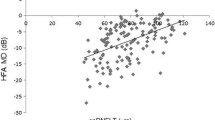Abstract
Background: The purpose of this study was to evaluate which of the structural and functional parameters – the Heidelberg Retina Tomograph (HRT), white-on-white (W/W) and blue-on-yellow (B/Y) visual fields and semiquantitative retinal nerve fiber layer (RNFL) scoring parameters – can give the best separation between non-glaucomatous and glaucomatous eyes.Methods: Fifty-five subjects were included in this study: 32 non-glaucomatous subjects with mean age of 54 years, and 23 patients with ocular hypertension or glaucoma and mean age of 59 years. The HRT with software 1.11, the Humphrey 30–2 W/W and lens coloration- corrected B/Y visual fields, and semiquantitative RNFL scores were utilized. Stepwise logistic regression analysis was used in finding, from a given set of parameters, a best discriminating parsimonious subset to a logistic model, the discriminatory performance of which was evaluated by the area under the ROC curve. Results: When all the structural and functional variables were considered, the RNFL total overall score gave the best separation between glaucomatous and non-glaucomatous eyes (ROC area 0.98). Without the RNFL scores and optic disc size-dependent HRT parameters in the model, the cup shape measure was selected first (ROC area 0.88). In the second step the RNFL thickness was selected (ROC area 0.91), and in the third step the corrected B/Y mean deviation (MD) was selected (ROC area 0.91). With only the HRT parameters in the model, the cup/disc ratio was selected first (ROC area 0.88). However, when the groups were matched for optic disc size, all disc size-dependent HRT variables lost their discriminant power.Conclusion: Cup shape measure and RNFL thickness, together with age- and lens coloration-corrected MD of the B/Y perimetry provided good discrimination between healthy individuals and patients with glaucoma.
Similar content being viewed by others
Author information
Authors and Affiliations
Additional information
Received: 6 May 1999 Revised: 3 November 1999 Accepted: 18 November 1999
Rights and permissions
About this article
Cite this article
Vihanninjoki, K., Teesalu, P., Burk, R. et al. Search for an optimal combination of structural and functional parameters for the diagnosis of glaucoma . Graefe's Arch Clin Exp Ophthalmol 238, 477–481 (2000). https://doi.org/10.1007/s004179900119
Issue Date:
DOI: https://doi.org/10.1007/s004179900119



